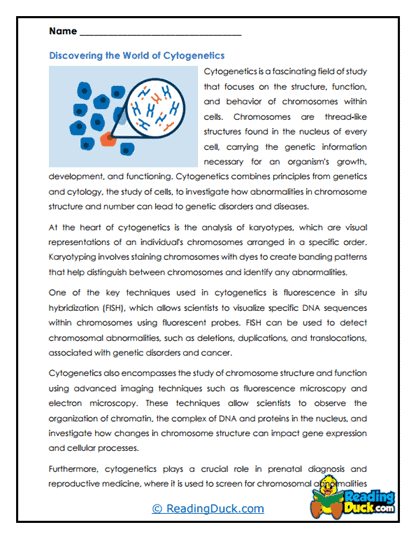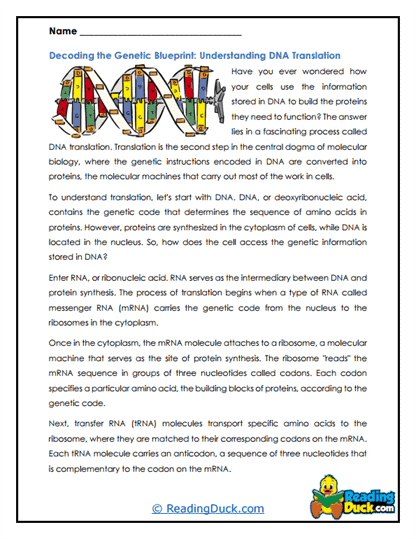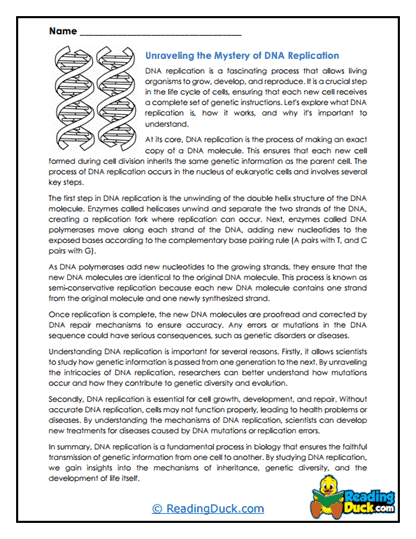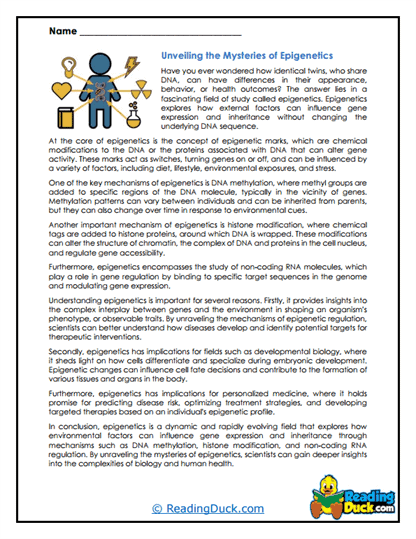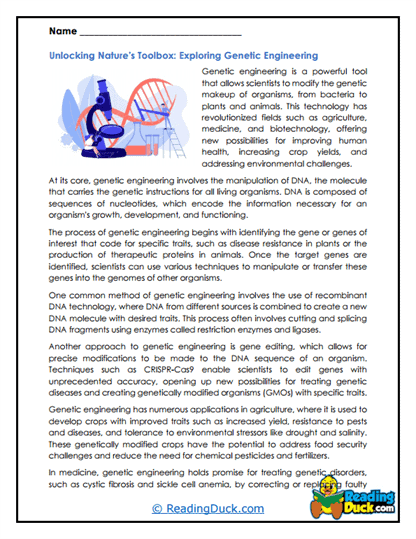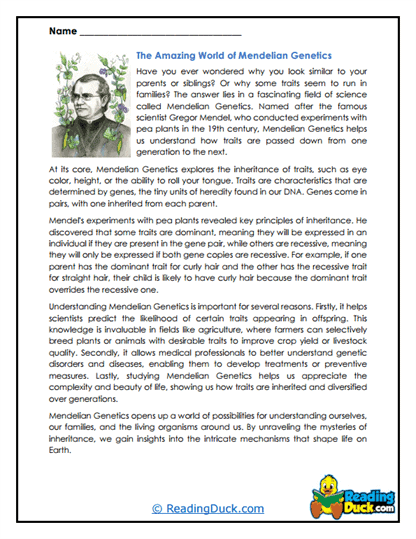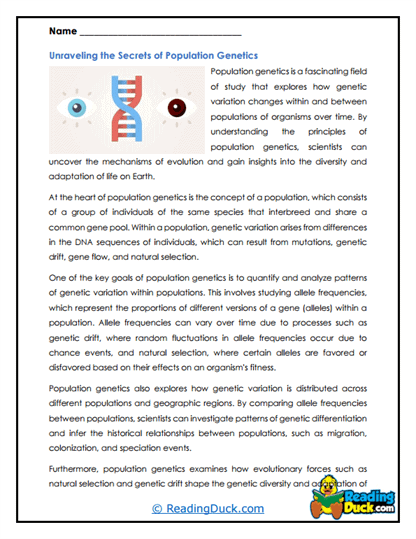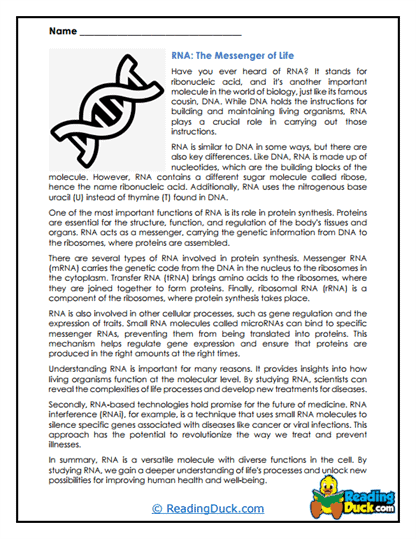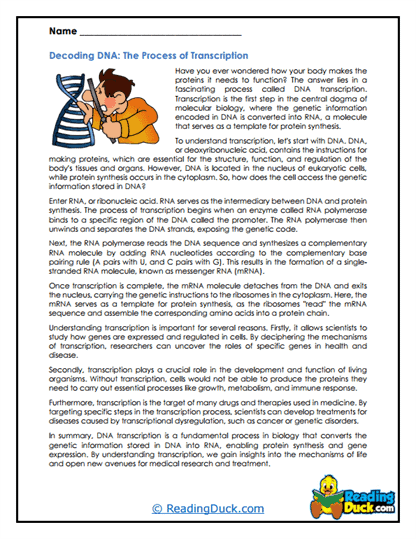Genetics Worksheets
About Our Genetics Worksheets
Our collection of Genetics worksheets provides a comprehensive introduction to the fundamental principles of heredity and the molecular mechanisms that underlie genetic traits. As a subtopic under Biology, these worksheets are designed to help students explore the fascinating world of genes, DNA, and inheritance in a straightforward and engaging way. Each worksheet set is crafted to reinforce key concepts through a variety of question formats and visual aids.
Each worksheet set includes:
- Multiple Choice Questions: These questions assess students' understanding of the reading passage by offering multiple answer choices, reinforcing essential facts and concepts about genetics.
- Short Answer Questions: In this section, students are encouraged to write their own answers to questions based on the reading passage. This format promotes a deeper understanding by allowing students to articulate what they have learned in their own words.
- Open-Ended Questions: These questions prompt students to provide personal input, opinions, or reflections related to the reading material. This format encourages students to connect the topic of genetics to their own experiences and broader understanding of biology.
An answer key is provided for all question sheets, making it easy for teachers and parents to review and assess students' work. All worksheets are available as PDF files, which can be easily viewed electronically, downloaded, and printed for use in classrooms or homeschool settings.
The Building Blocks of Life: Understanding Genetics
Genetics is the study of how traits are passed from one generation to the next. It is a field that delves into the molecular instructions that govern the development, functioning, and reproduction of living organisms. When introducing students to genetics, it's essential to start with the basics: what genes are, how they are inherited, and how they influence the characteristics of organisms. Genetics is a foundational topic in biology because it explains the diversity of life and provides insights into everything from human health to agricultural practices.
What Are Genes?
Genes are the basic units of heredity. They are segments of DNA (deoxyribonucleic acid) that contain the instructions for building and maintaining an organism. Each gene is a specific sequence of nucleotides within the DNA that encodes for a particular protein or functional RNA. These proteins and RNAs are responsible for the traits we see in organisms, such as eye color, hair texture, and even susceptibility to certain diseases.
Key Concepts in Genetics
- DNA and the Genetic Code
- DNA Structure: DNA is a double-stranded molecule that forms a double helix. It is composed of four types of nucleotides: adenine (A), thymine (T), cytosine (C), and guanine (G). The sequence of these nucleotides in the DNA strand determines the genetic information carried by a gene.
- Genetic Code: The genetic code is the set of rules by which the information encoded in DNA is translated into proteins. Each group of three nucleotides, known as a codon, specifies a particular amino acid, which is the building block of proteins.
- Chromosomes and Inheritance
- Chromosomes: Genes are organized into structures called chromosomes, which are found in the nucleus of eukaryotic cells. Humans have 23 pairs of chromosomes, with one set inherited from each parent. Chromosomes carry hundreds to thousands of genes, and they play a crucial role in inheritance.
- Inheritance Patterns: Traits are passed from parents to offspring through different inheritance patterns. These include dominant and recessive traits, codominance, incomplete dominance, and sex-linked traits. Understanding these patterns helps explain why certain traits appear in some generations and not in others.
- Mendelian Genetics
- Gregor Mendel: The field of genetics began with the work of Gregor Mendel, an Austrian monk who studied the inheritance of traits in pea plants. Mendel discovered the basic principles of inheritance, which are now known as Mendel's Laws: the Law of Segregation and the Law of Independent Assortment.
- Punnett Squares: Punnett squares are a tool used to predict the possible genetic outcomes of a cross between two organisms. By analyzing the combinations of alleles (different forms of a gene), students can determine the probability of an offspring inheriting a particular trait.
- Mutations and Genetic Variation
- Mutations: Mutations are changes in the DNA sequence that can lead to variations in the genetic code. Some mutations have no effect, while others can cause changes in the function of a gene, potentially leading to genetic disorders or variations in traits.
- Genetic Diversity: Mutations, along with processes like recombination and independent assortment during meiosis, contribute to genetic diversity. This diversity is essential for the survival and evolution of species, as it provides the raw material for natural selection.
- Genetic Disorders and Biotechnology
- Genetic Disorders: Some mutations can lead to genetic disorders, which are diseases or conditions caused by abnormalities in the genetic code. Examples include cystic fibrosis, sickle cell anemia, and Down syndrome. Understanding the genetic basis of these disorders is crucial for diagnosis, treatment, and prevention.
- Biotechnology: Advances in genetics have led to the development of biotechnology, a field that uses genetic information to create new technologies and products. This includes genetic engineering, cloning, and gene therapy, which have applications in medicine, agriculture, and industry.
Real World Applications
The study of genetics has profound implications for many areas of science and society. Understanding genetics allows us to tackle challenges in medicine, agriculture, and conservation, among other fields.
Medicine and Healthcare
- Genetic Testing and Personalized Medicine
- Genetic Testing: Genetic testing allows individuals to learn about their genetic makeup and potential risks for inherited diseases. This information can be used to make informed decisions about health care, including preventive measures and early interventions.
- Personalized Medicine: Personalized medicine is an approach to healthcare that tailors treatment based on an individual's genetic profile. By understanding a patient's genetic makeup, doctors can prescribe medications and therapies that are more likely to be effective and have fewer side effects.
- Gene Therapy and Genetic Engineering
- Gene Therapy: Gene therapy is a cutting-edge medical treatment that involves altering a person's genes to treat or prevent disease. This can include replacing a faulty gene with a healthy one, inactivating a malfunctioning gene, or introducing a new gene to help fight a disease.
- Genetic Engineering: Genetic engineering involves modifying the genetic code of an organism to achieve desired traits. This technology is used in medicine to produce insulin, human growth hormone, and other therapeutic proteins. It is also used in agriculture to create crops that are resistant to pests, diseases, and environmental stresses.
Agriculture and Food Production
- Crop Improvement and GMOs
- Genetically Modified Organisms (GMOs): GMOs are organisms that have been genetically engineered to exhibit certain traits, such as resistance to pests, herbicides, or environmental conditions. GMOs play a significant role in modern agriculture by improving crop yields, reducing the need for chemical inputs, and enhancing nutritional content.
- Selective Breeding: Even before the advent of genetic engineering, farmers used selective breeding to enhance desirable traits in plants and animals. Understanding genetics helps improve these traditional methods by providing insights into which traits are most beneficial and how they can be passed on to future generations.
- Sustainable Agriculture
- Conservation of Genetic Resources: The conservation of genetic diversity in crops and livestock is critical for sustainable agriculture. Genetic diversity allows species to adapt to changing environmental conditions, resist diseases, and improve productivity. Efforts to preserve heirloom varieties and wild relatives of crops are essential for maintaining this genetic reservoir.
Conservation and Biodiversity
- Conservation Genetics
- Genetic Monitoring: Conservation genetics involves studying the genetic diversity within and between populations of endangered species. Genetic monitoring can help conservationists understand population dynamics, identify genetic bottlenecks, and develop strategies to preserve biodiversity.
- Restoring Populations: In some cases, genetics can be used to restore populations of endangered species. This might involve breeding programs that increase genetic diversity or using genetic information to reintroduce species to their natural habitats.
- Ethical Considerations in Genetics
- Ethics of Genetic Modification: The ability to manipulate the genetic code raises important ethical questions. Debates surrounding the use of GMOs, gene therapy, and cloning often center on concerns about safety, environmental impact, and the potential for unintended consequences.
- Informed Consent and Privacy: In the field of genetics, it is crucial to ensure that individuals understand the implications of genetic testing and that their genetic information is kept private and secure. Informed consent and privacy are key ethical principles that guide the use of genetic technology.
The Significance of Genetics
Genetics is a field that touches nearly every aspect of life. From understanding the diversity of living organisms to tackling some of the most pressing challenges in medicine and agriculture, the study of genetics is foundational to modern science. By learning about genetics, students gain insight into the mechanisms that drive evolution, the complexity of inheritance, and the potential of biotechnology to shape the future. The knowledge gained from studying genetics not only enhances our understanding of life itself but also empowers us to make informed decisions about health, the environment, and the ethical use of technology in society.
